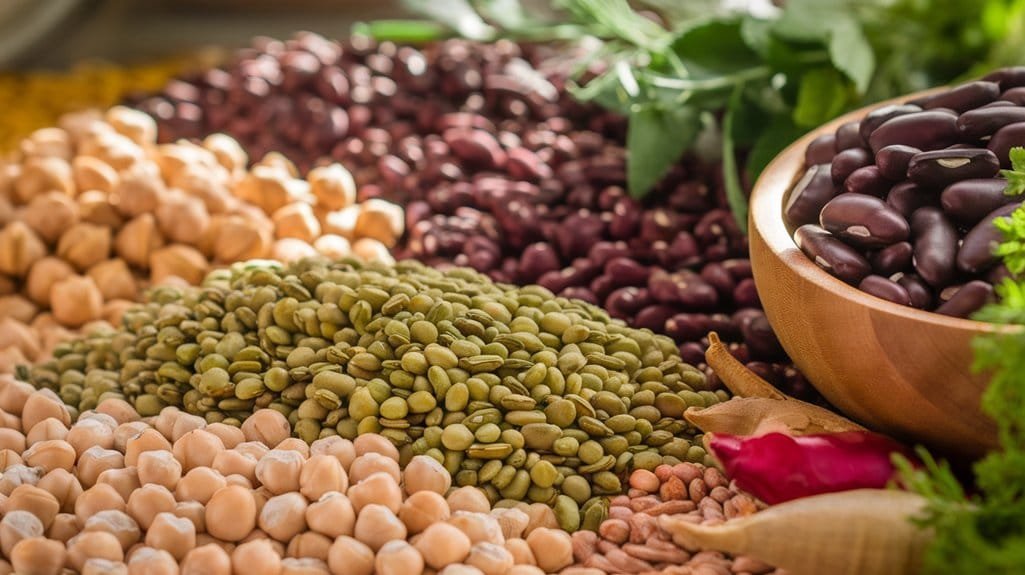When you're on semaglutide, focus on nutrient-dense foods to maximize its benefits. Non-starchy vegetables like spinach and asparagus are great for digestion and blood sugar control. Incorporate lean proteins such as chicken, fish, and eggs to maintain muscle mass and keep you feeling full. Legumes, like lentils and chickpeas, are high in fiber and protein, promoting satiety. Whole grains, such as brown rice and quinoa, provide sustained energy while healthy fats from avocados and nuts support heart health. This balanced approach can optimize your results, and there's more to explore about effective meal options.
Key Takeaways
- Focus on non-starchy vegetables, like spinach and cauliflower, to stabilize blood sugar and enhance gut health.
- Incorporate lean proteins such as chicken, fish, and plant-based options to promote satiety and maintain muscle mass.
- Utilize legumes like lentils and chickpeas, which provide high protein and fiber to manage blood sugar levels effectively.
- Choose whole grains, such as quinoa and brown rice, for complex carbohydrates that sustain energy and enhance nutrient intake.
- Include healthy fats from sources like avocados and fatty fish to improve heart health and maintain a sense of fullness.
Non-Starchy Vegetables

When you're managing your diet on semaglutide, incorporating non-starchy vegetables can make a significant difference. These vegetables are low in calories and carbohydrates, making them ideal for stable blood sugar regulation. The fiber benefits are substantial; they aid digestion and prevent rapid blood sugar spikes, promoting overall gut health. In addition to their low glycemic index, these vegetables also help support metabolic health by preventing sudden cravings, which is particularly beneficial while using semaglutide. This aligns with the need for sustainable changes in dietary habits that are essential for long-term success. Non-starchy vegetables like spinach, cauliflower, and asparagus aren't only nutrient-dense but also support gut bacteria with their prebiotic properties.
Protein Foods
Incorporating protein foods into your diet while on semaglutide is essential for maintaining muscle mass and promoting satiety. Focus on lean protein sources such as chicken breasts, lean beef, and pan-seared fish like salmon or swordfish. Eating these protein sources can further enhance insulin sensitivity, which is important for overall metabolic health. Eggs are another excellent choice, providing you with quality protein. Greek yogurt and cottage cheese serve as high-protein snacks, perfect for keeping hunger at bay. For plant-based options, consider tofu and whole grains like quinoa, which are both rich in protein. Distributing your protein intake evenly throughout the day—aiming for 20 to 30 grams per meal—will help you manage cravings and stabilize blood sugar levels. Prioritize these protein-rich foods for a balanced and effective approach to your semaglutide journey.
Legumes

Legumes are a powerhouse of nutrition that can enhance your diet while on semaglutide, especially due to their high protein and fiber content. The legume benefits extend beyond satiety; they help regulate blood sugar with their low glycemic index, promoting stable energy levels. Incorporating lentils, chickpeas, black beans, kidney beans, and split peas into your meals can support digestive health and reduce the risk of chronic diseases. Additionally, consuming legumes can help with glycemic control as they are rich in fiber and protein, which can mitigate blood sugar spikes. You can use various cooking techniques, like simmering soups or blending chickpeas into hummus, to easily include these nutrient-rich foods. Pair legumes with vegetables or whole grains for balanced meals. Whether it's a hearty salad or a side dish, they'll enhance both flavor and nutrition in your diet.
Whole Grains
Whole grains are an essential part of a nutritionally balanced diet, especially for those using semaglutide.
They're rich in fiber benefits, which help regulate digestion and maintain steady blood sugar levels.
By incorporating grain sources like brown rice, whole wheat bread, oats, quinoa, and barley into your meals, you can enhance your nutrient intake.
These foods not only provide complex carbohydrates for sustained energy but also contain crucial vitamins and minerals essential for overall health.
Whole grains keep you feeling fuller longer, reducing hunger cravings and supporting weight management goals.
Replacing refined grains with whole alternatives can notably lower your risk of diabetes and heart disease, making them a smart choice for anyone aiming for mastery in healthy eating on semaglutide.
Healthy Fats and Nuts

Healthy fats and nuts are essential components of a balanced diet, especially for those using semaglutide. Incorporating these foods can enhance your health and support your weight management goals.
Consider these options:
- Avocados: Rich in monounsaturated fats, they're linked to improved heart health and reduced cholesterol.
- Fatty Fish: Salmon and sardines are excellent omega-3 sources, promoting cardiovascular wellness.
- Nuts and Seeds: Almonds and flaxseeds provide protein and fiber, contributing to satiety and digestive health.
- Olive Oil: A versatile fat for cooking, it supports energy production and heart health.
Emphasizing healthy fats not only aids hormone balance but also helps maintain fullness, making them key allies in your semaglutide journey.
Frequently Asked Questions
Can I Eat Fruits While on Semaglutide?
Yes, you can eat fruits while managing your health. Their benefits include essential nutrients and fiber that aid digestion. Just be mindful of portion sizes to maintain balanced blood sugar levels and support overall wellness.
What Are the Best Cooking Methods for These Foods?
Did you know steaming preserves about 90% of nutrients? You'll love exploring grilling techniques for protein and veggies, while diverse steaming options keep your meals nutritious and flavorful, making healthy eating effortless and enjoyable.
How Often Should I Eat These Foods?
You should aim for regular meal frequency and practice portion control. Eating smaller, balanced meals every three to four hours can help manage hunger, stabilize blood sugar, and enhance nutrient absorption throughout the day.
Are There Any Foods to Avoid Completely?
You should avoid high-calorie snacks and refined sugars, as they can lead to weight gain and hinder your progress. Focusing on whole, unprocessed foods will help you maintain balanced energy levels and overall health.
How Do These Foods Affect Weight Loss on Semaglutide?
These foods enhance nutrient absorption and affect meal timing, promoting satiety. Incorporating them into your diet can optimize weight loss, helping you manage calories effectively while supporting overall health in your weight management journey.
Conclusion
Incorporating non-starchy vegetables, protein sources, legumes, whole grains, and healthy fats can greatly enhance your journey on semaglutide. Think of your plate as a vibrant palette, where each food choice adds not just color but health benefits, helping you feel more energetic and satisfied. By choosing nutrient-dense options, you're not just feeding your body, but also empowering it. Embrace these foods, and watch as your well-being flourishes. After all, healthy eating isn't just a diet; it's a lifestyle.





